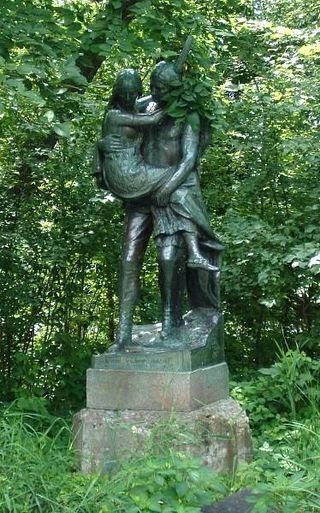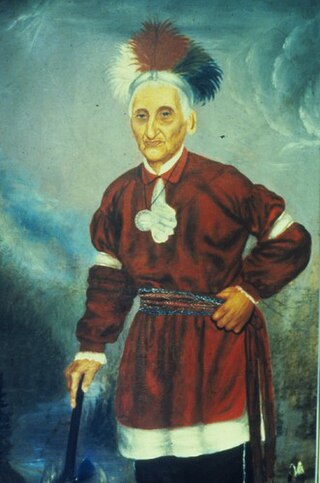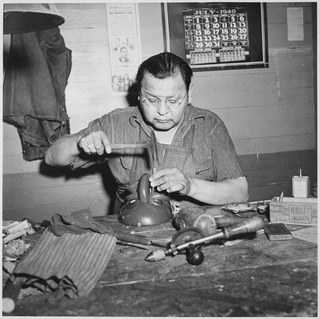
Allegany Reservation is a Seneca Nation of Indians reservation in Cattaraugus County, New York, U.S. In the 2000 census, 58 percent of the population within the reservation boundaries were Native Americans. Some 42% were European Americans; they occupy properties under leases from the Seneca Nation, a federally recognized tribe. The population outside of the rented towns was 1,020 at the 2010 census. The reservation's Native American residents are primarily members of the Seneca, but a smaller number of Cayuga, another Iroquois nation, also reside there, and at least one family is known to have descended from the Neutral Nation. Prior to the 17th century, this area was occupied by the Iroquoian-speaking Wenrohronon and Eriehronon. The more powerful Seneca eliminated these competing groups during the Beaver Wars beginning in 1638, as the Iroquois Confederacy sought to control the lucrative fur trade with the French and Dutch colonists.
The year 1909 in film involved some significant events.

Hiawatha, also known as Ayenwatha or Aiionwatha, was a precolonial Native American leader and cofounder of the Iroquois Confederacy. He was a leader of the Onondaga people, the Mohawk people, or both. According to some accounts, he was born an Onondaga but adopted into the Mohawks.

Among the Haudenosaunee the Great Law of Peace, also known as Gayanashagowa, is the oral constitution of the Iroquois Confederacy. The law was written on wampum belts, conceived by Dekanawidah, known as the Great Peacemaker, and his spokesman Hiawatha. The original five member nations ratified this constitution near modern-day Victor, New York, with the sixth nation being added in 1722.

The Song of Hiawatha is an 1855 epic poem in trochaic tetrameter by Henry Wadsworth Longfellow which features Native American characters. The epic relates the fictional adventures of an Ojibwe warrior named Hiawatha and the tragedy of his love for Minnehaha, a Dakota woman. Events in the story are set in the Pictured Rocks area of Michigan on the south shore of Lake Superior. Longfellow's poem is based on oral traditions surrounding the figure of Manabozho, but it also contains his own innovations.

Minnehaha Park is a city park in Minneapolis, Minnesota, United States, and home to Minnehaha Falls and the lower reaches of Minnehaha Creek. Officially named Minnehaha Regional Park, it is part of the Minneapolis Park and Recreation Board system and lies within the Mississippi National River and Recreation Area, a unit of the National Park Service. The park was designed by landscape architect Horace W.S. Cleveland in 1883 as part of the Grand Rounds Scenic Byway system, and was part of the popular steamboat Upper Mississippi River "Fashionable Tour" in the 1800s.
Hiawatha (Haiëñ'wa'tha) is a Native American semi-historical figure who was the co-founder of the Iroquois Confederacy.

John Abeel III known as Gaiänt'wakê or Kaiiontwa'kon in the Seneca language and thus generally known as Cornplanter, was a Dutch-Seneca chief warrior and diplomat of the Seneca people. As a war chief, Cornplanter fought in the American Revolutionary War on the side of the British. After the war Cornplanter led negotiations with the United States and was a signatory of the Treaty of Fort Stanwix (1784), the Treaty of Canandaigua (1794), and other treaties. He helped ensure Seneca neutrality during the Northwest Indian War.

Minnehaha is a Native American woman documented in Henry Wadsworth Longfellow's 1855 epic poem The Song of Hiawatha. She is the lover of the titular protagonist Hiawatha and comes to a tragic end. The name, often said to mean "laughing water", literally translates to "waterfall" or "rapid water" in Dakota.

The Independent Moving Pictures Company (IMP) was a motion picture studio and production company founded in 1909 by Carl Laemmle. The company was based in New York City, with production facilities in Fort Lee, New Jersey. In 1912, IMP merged with several other production companies to form Universal Film Manufacturing Company, later re-named Universal Pictures Company with Laemmle as president.

Tah-won-ne-ahs or Thaonawyuthe, known in English as either Chainbreaker to his own people or Governor Blacksnake to the European settlers, was a Seneca war chief and sachem. Along with other Iroquois war chiefs, he led warriors to fight on the side of the British during the American Revolutionary War from 1777 to 1783. He was prominent for his role at the Battle of Oriskany, in which the Loyalist and allied forces ambushed a force of Patriots. After the war, he supported his maternal uncle, Handsome Lake, as a prominent religious leader. Chainbreaker allied with the United States in the War of 1812 and later encouraged some accommodation to European-American settlers, allowing missionaries and teachers on the Seneca reservation.

Longfellow is a defined community in Minneapolis, Minnesota which includes five smaller neighborhoods inside of it: Seward, Cooper, Hiawatha, Howe and Longfellow. The community is a mix of agri-industrial properties along the old Northern Pacific Railway, expansive parkland surrounding the famous Minnehaha Falls, and smaller residential areas.

Jesse J. Cornplanter was an actor, artist, author, craftsman, Seneca Faithkeeper and decorated veteran of World War I. The last male descendant of Cornplanter, an important 18th-century Haudenosaunee leader and war chief, his Seneca name was Hayonhwonhish. He illustrated several books about Seneca and Iroquois life. Jesse Cornplanter wrote and illustrated Legends of the Longhouse (1938), which records many Iroquois traditional stories. Cornplanter was also the first Native American to play a lead in a feature film titled Hiawatha, which was released in 1913 and a year before the notable Western The Squaw Man.

John Joseph Braham, Sr. was an Anglo-American musical theater conductor and composer who introduced the works of Gilbert and Sullivan to the United States and composed some of the earliest original orchestral scores for silent film.

Hiawatha is a 1952 American Western film based on the 1855 epic poem The Song of Hiawatha by Henry Wadsworth Longfellow, centering on Native Americans in pre-Columbian times. Directed by Kurt Neumann, with stars Vincent Edwards and Yvette Dugay, it became the final feature produced by the low-budget Monogram Pictures, a mainstay of Hollywood's Poverty Row.

Sanford Plummer (Seneca) was a Native American narrative watercolor painter from New York state. He painted works portraying traditional life and culture of the Seneca and people of other Iroquois nations. His works are held by the Iroquois Indian Museum, as well as Buffalo Museum of Science, Rochester Museum and Science Center, and the Newark Museum.

Hiawatha and Minnehaha is a sculpture by Jacob Fjelde that has stood in Minnehaha Park in Minneapolis since the early twentieth century. Now a popular fixture of the park, its placement there was originally controversial.

Edward Cornplanter or So-son-do-wa (1856–1918) was a chief of the Seneca people of the Iroquois Nation (Haudenosaunee) and a leading exponent of the Code of Handsome Lake.
Pugasaing is a Native American dice game played by the Ojibwe. It is mentioned by name in Henry Wadsworth Longfellow's poem, The Song of Hiawatha. The word pugasaing is the participle form of the verb "to throw" in the Ojibwe language.

Hiawatha and Minnehaha are 1868 sculptures by Edmonia Lewis. They are in the collection of the Metropolitan Museum of Art on view in gallery 759.
















